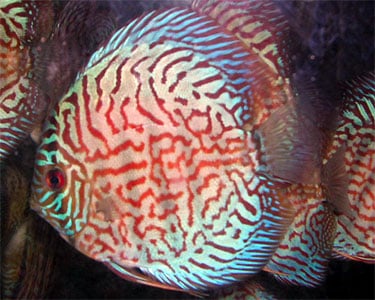
Common Name: Red Turquoise Discus, Discus
Scientific Name: Symphysodon Aequifaciatus sp.
Average Adult Fish Size: 8 inches / 20 cm
Place of Origin: Amazon basin of S. America
Typical Tank Setup: Well planted with driftwood / bogwood and some rock work.
Recommended Minimum Aquarium Capacity: 40 gallon / 160 litre
Compatibility: Discus are a very peaceful fish and should be kept with other peaceful fish like some of the S. American dwarf cichlid species and tetras. They do best when kept as a group of 6 or more.
Temperature: 82 – 88 Deg F / 28 – 30 Deg C
Water Chemistry: Juvenile and wild F1 Discus generally require softer water and a lower pH than tank raised Discus. The best thing is to simulate the conditions your Discus were raised in. Wild Discus require pH 6.0 – 6.5 while tank raised Discus can go all the way up to 8.0 pH.
Feeding: When purchasing, always ask what they are being fed. Discus can be quite particular when it comes to food, but can be trained to readily accept almost any type of food. Tank mates that eat the food that you want them to eat will encourage Discus to eat it also. They WILL eat a broad range of foods from flakes, small pellets, frozen, and live worms along with brine shrimp, but not always on the first attempt. DO NOT feed them tubifex worms. Tubifex carries too many pathogens and the risk of introducing disease to your Discus is too great a risk. Hole-in-the-head disease (HITH) is associated with poor water quality and feeding tubifex.
Sexing: Venting is the best way to sex Discus.
Breeding: Discus will lay their eggs on broad leaved plants like Amazon Swords or almost any vertical flat surface that is to their liking. Fry are best kept with the parents as they will eat the slime that the parents secrete. At two weeks of age they will start to accept finely ground flake food or baby brine shrimp.
Additional Information: There are almost too may different color variations of Discus with new ones coming out all the time. They are not difficult to keep as long as water parameters and temperature are to their liking. They can be a shy fish, because of this the aquarium should not be placed in high traffic areas where people are always walking by. A novice fish keeper will have better success with Discus that are larger than 3 inches in size.
Red Turquoise Discus originate from the Amazon River Systems of South America, where they were first imported into the aquarium hobby in the early 1930s. Ever since their introduction into the hobby to this day, Discus are considered one of the most colorful, demanding, rewarding and expensive of all tropical freshwater aquarium fish species. Due to their popularity and the high price tag that they command, Discus are very popular with fish breeders. Over the years breeders have not only raised enough tank-bred specimens to largely fulfill the demand from the aquarium hobby, but have developed completely new color strains and patterns as well. Discus are very popular amongst intermediate to advanced fish keepers, and are widely considered to be one of the most rewarding and challenging to keep of the freshwater tropical community fish species available within the hobby.


Related Posts
Croaking Gourami – Trichopsis vittatus
Paradise Fish – Macropodus opercularis
Schubert’s Barb – Barbus Semifasciolatus